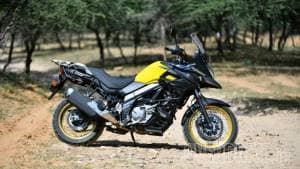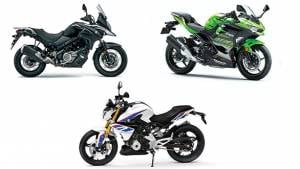Suzuki V-Strom 650 XT vs Kawasaki Versys 650 comparison test
Adventure tourers are apt for a country like ours, and the growing number of this breed of motorcycles on our roads is proof of how effective and popular they really are. Whether it's power, comfort, ease of riding, or simply grabbing attention (yes, some buying decisions are still made on that basis), ADVs, as they are popularly known, continue to remain sought after. In the middleweight segment of this large pie, is the Kawasaki Versys 650, a motorcycle we absolutely love for its handling, engine and rider involvement. It went on to sell in good numbers with no real competition in the vicinity. Up until now, that is. Say hello to the new Suzuki V-Strom 650 XT, an adventure tourer that holds immense promise and brings more kit for a small premium. Let's see what happens when the two Japanese heavyweights enter the battle ring.
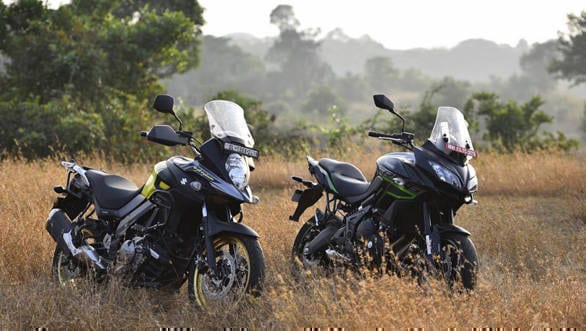
Style and build
These motorcycles were designed with completely different ideas in mind and it's evident in the way they look. The V-Strom is clearly the focussed dual-purpose motorcycle of the two, built to cruise on highways as well as venture off-tarmac, on a whim. Its styling is skewed towards the traditional adventure motorcycle design language, made obvious by the beak, large fuel tank and minimal rear. And then there are those lovely gold, wire-spoke rims that certainly won't look out of place in a rap video.
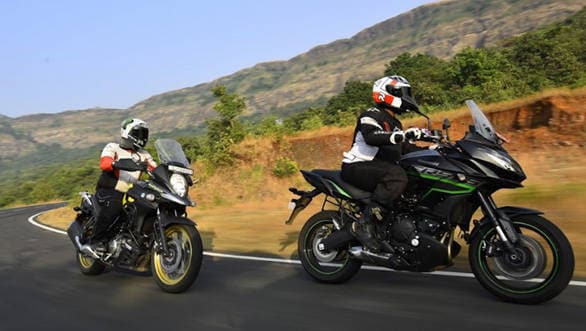
The Suzuki also looks much larger than the Kawasaki which adopts a contrasting design language. My favourite bit about the design is the aggressive twin-headlamp fairing and the stealth black paint job with a dash of fluro green stripes. Its road biased design is also made apparent by the alloy wheels, with fatter rubber. Standing next to each other, it's the Suzuki that grabs more eyeballs and is the more purposeful looking adventure motorcycle here. As far as quality as well as fit and finish is concerned, both are equally matched, whether it's the plastics and switchgear or the way the panels are screwed together.
Ergonomics
It is the same story when it comes to the way you are seated on the bikes. At 840mm, the Versys' perch is high while the footpegs are slightly rear set and the handlebars are narrower and closer to the rider. It's like sitting on a tall, sporty street bike and it feels natural from the word go. I also found the seat on the Versys was better contoured but not as spacious as the V-Strom's.
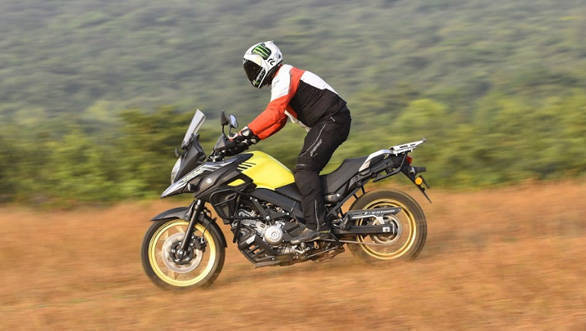

Suzuki has managed to strike an ergonomic balance for both on-road and off-road riding. You sit lower (835mm), the pegs are not as rear set as the Versys' and the handlebars are wider. So, long stints on the road are easy, however, the firm seat will take some kilometers to get used to. And when you hit the trails, the shape of the tank helps you hold on to the bike whereas the wide handlebars allow more leverage to manoeuvre around or over obstacles. Where the Kawasaki scores a point over the Suzuki is the inclusion of adjustable clutch and brake levers as standard, while the V-Strom only gets adjustment for the latter.
Engine and performance
Both motorcycles employ a twin-cylinder, liquid-cooled engine displacing close to 650cc but the Suzuki uses a V-twin layout while the Kawasaki sticks to a parallel-twin setup. And that translates to two engines with characters as different as chalk and cheese.

The V-Strom's motor is very refined and produces oodles of torque in the low and mid section of the rev range. That makes it relatively stress-free to ride in urban areas as you don't need to keep shifting gears to stay in the power band. 40kmph in sixth won't cause the engine to protest and a gentle roll on the throttle will see the bike surge forward cleanly. 0-100kmph comes up in a 5.08s which is quick by adventure bike standards. For perspective, a full-sized adventure bike like the Triumph Tiger 1200 Explorer manages the 0-100kmph dash in 5.1s. Power delivery is very linear, allowing you to make precise throttle inputs which is imperative while riding off road. But even if you are ham-fisted or have just graduated to a big bike, the Suzuki's clever traction control system will keep you out of harm's way. The two-stage system alters the level of intervention and you can turn it off completely, if you've got the globes or have mastered the fine art of sliding a big ADV bike.
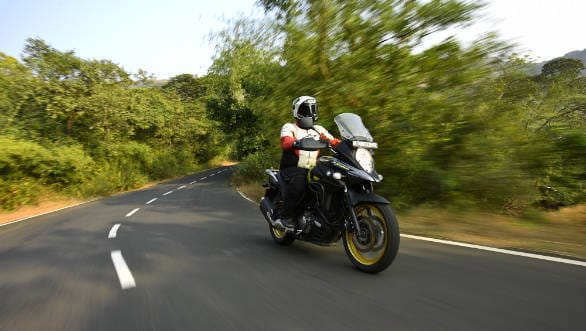
Besides the motor's tractability, what I really loved is its ability to cruise stress-free. At 100kmph, the rev needle hovers at 4,500rpm only and it'll comfortably cruise between 120-140kmph without any pit stops. This calm nature of the engine translates to great fuel economy as well, with the V-Strom managing 23.5kmpl in the city and 28.2kmpl on the highway. The Versys' engine is identical to the Ninja 650's which makes it a rev happy engine. That's not to say that there's no poke in the low and mid rpm range but this motor really comes alive after 7,000rpm. There's this surge in power once you rev past that point and it gets addictive, to say the least. If you like quick and urgent power delivery, you'll love the Versys. It feels like it's fast and I thought it was quicker before we strapped the Vbox. It clocked 5.28s from 0-100kmph but that's not a significant margin. Where the Kawasaki falls back slightly is at the pumps. In the city it returned 21.1kmpl and the figure rose to 26.8 kmpl on the highway. This despite both bikes weighing an identical 216kg. It just shows how relaxed the Suzuki's motor is in the real world.
Ride and handling
The difference in approach continues here as well. The V-Strom utilises a twin-spar aluminum frame with conventional forks and a preload adjustable monoshock at the rear. The Versys, on the other hand, uses a steel, diamond frame with rebound and preload adjustable USD forks and an adjustable, offset monoshock.
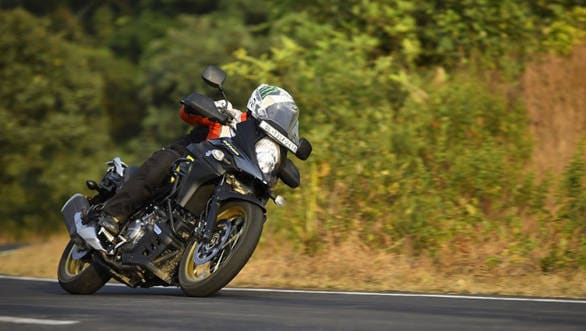
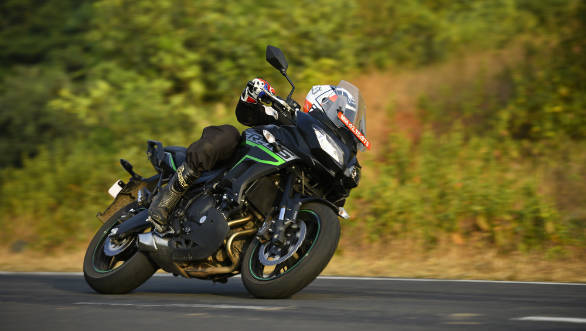
Riding over small undulations and bumps, both motorcycles remain poised as the suspension gobbles up imperfections with aplomb. However, when you encounter big potholes, the Kawasaki's sophisticated suspension shines through. That said, the wire spoke wheels on the Suzuki are capable of handling a proper thrashing over bad roads but over similar surfaces and speeds, one needs to keep an eye out for sharp edges that could bend the alloys on the Kawasaki.
The Versys is definitely the better corner carver here with the smaller, 17-inch wheels, road biased Dunlop Sportmax tyres and advanced suspension setup offering tonnes of feedback. The short wheelbase also makes the Versys a delight to flick around chicane.
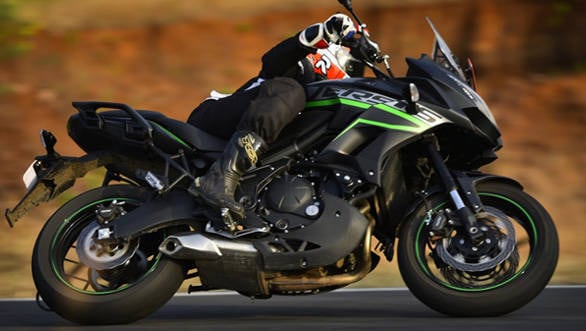
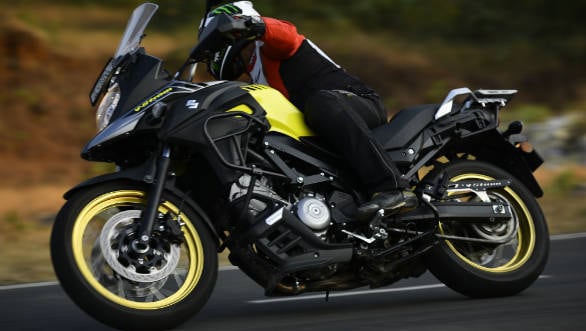
The V-Strom, at this point may not seem as thrilling to ride on the road, but that's not the case. Sure it can't match the corner speeds that Versys carries but the difference isn't huge. The bike feels planted in a corner, with decent amount of feedback from the large, 19-inch wheel and Bridgestone Battlax Adventure dual-purpose tyres. The longer wheelbase, at 1,560mm also contributes to mid-corner stability and on the whole, the V-Strom handles rather well for its size and off-road ability. The brakes on Kawasaki are slightly better though since they are both, sharper and progressive than the Suzuki's unit. Also, the ABS calibration is much better on the Versys.
Verdict
These are two extremely capable and well built motorcycles that promise to give newbies as well as experienced riders a great time astride their respective saddles. The Kawasaki continues to be a fast, fun and effective adventure tourer that will happily munch miles, all day long. But that's only on tarmac. Try riding it off-road and you quickly realise that the small wheels and road biased tyres are simply not suited for that environment.
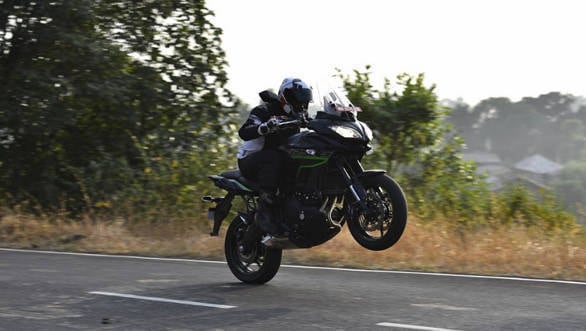
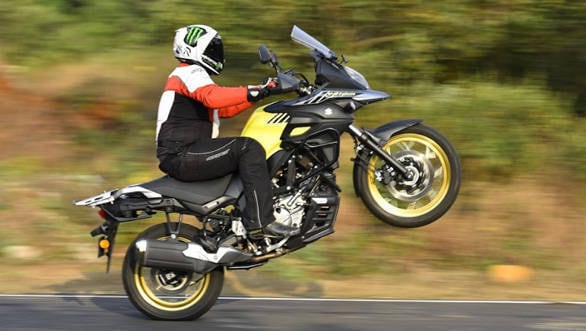
And that's where the Suzuki V-Strom 650 edges ahead. Besides good on road dynamics and a relaxed cruising demeanour, the wire spoke wheels, with tubeless tyres lend the bike serious off-road/ bad road ability as well. And then there is the added safety net of traction control which is a big plus in my books, given the terrible state of our roads. There is no question that the V-Strom is the better bike, and the Rs 77,000 premium it asks for is completely justified.

Images by Anis Shaikh
Also see:
CFmoto 650MT and the Suzuki V-Strom 650 XT
Starts Rs 6,79,000
649cc
6-Speed
69.00
64.00
-NA-
Starts Rs 8,84,804
645cc
6-Speed
71.00
62.00
-NA-
